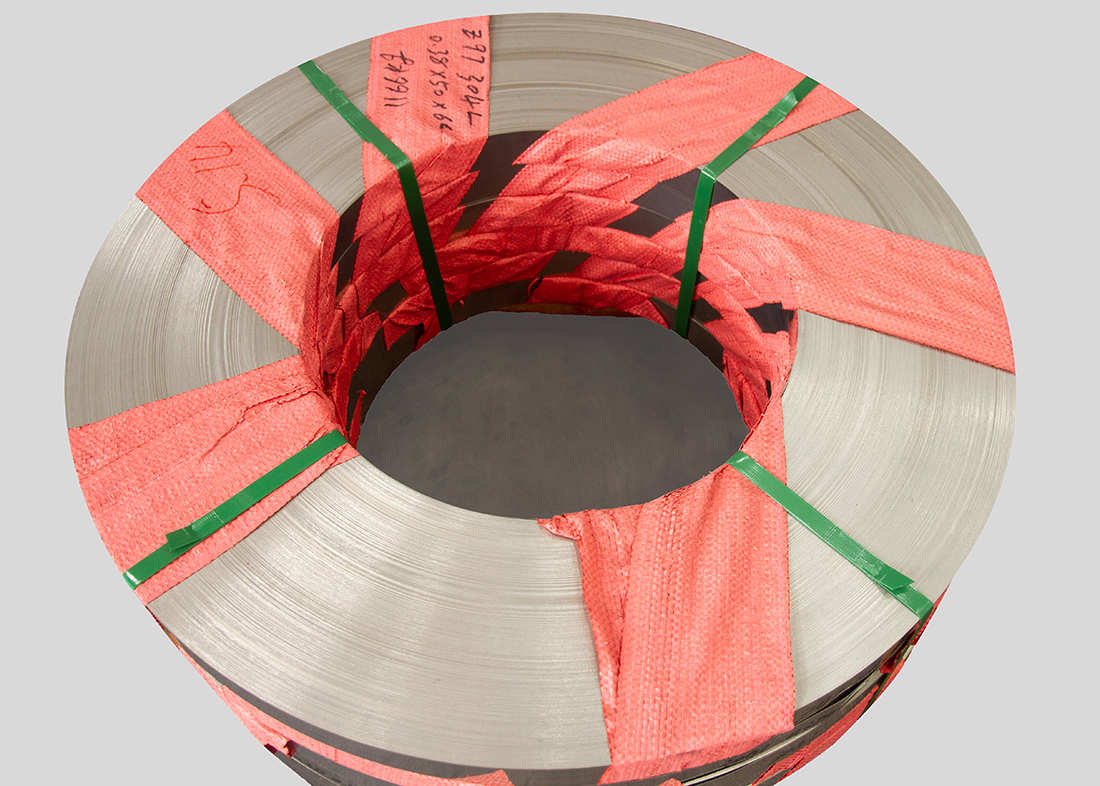
What are the surface treatment methods for stainless steel coils
source:goldinn.cn | Release time:2024年11月13日Acid washing process:
Acid washing is an important step in the surface treatment of stainless steel coils, with the main purpose of removing oxide scale, rust, and other impurities from the surface of stainless steel. Typically, acidic solutions such as a mixture of nitric acid (HNO ∝) and hydrofluoric acid (HF) are used. Nitric acid has strong oxidizing properties and can oxidize low valence oxides on metal surfaces into high valence oxides, while hydrofluoric acid can effectively dissolve impurities such as silicon oxide, which may adhere to the surface during stainless steel production. For example, for stainless steel coils containing a high amount of oxide scale, the pickling solution can undergo a chemical reaction with them, causing the oxide scale to dissolve and peel off.
During the pickling process, stainless steel coils are generally soaked in pickling tanks, and the soaking time varies depending on factors such as the material of the stainless steel and the thickness of the oxide layer, and the time is not very certain. At the same time, in order to ensure the uniformity of the pickling effect, a stirring device is usually equipped in the pickling tank to allow the pickling solution to fully contact every part of the stainless steel coil.
2.Passivation process:
Passivation is the formation of a dense passivation film on the surface of stainless steel after acid washing, which can effectively prevent further oxidation and corrosion of the stainless steel surface. Passivation can be achieved through chemical immersion or electrochemical methods. The chemical immersion method is to immerse the pickled stainless steel coil in a passivation solution containing an oxidant, such as nitric acid solution or sodium dichromate (Na ? Cr ? O ?) solution. The oxidant will react with the metal atoms on the surface of stainless steel, forming a passive film mainly composed of metal oxides.
Electrochemical passivation is the use of the principle of electrolysis, where stainless steel coils are used as anodes and undergo passivation reactions on the surface of stainless steel through the action of current in a specific electrolyte. This method can more accurately control the thickness and quality of the passivation film. The thickness of the passivation film is generally between a few nanometers and tens of nanometers. Although it is very thin, it has a strong protective effect.
2. Bright annealing treatment
Annealing principle:
Bright annealing is mainly used to improve the surface glossiness of stainless steel coils. During the annealing process, the stainless steel coil is heated to a certain temperature, typically between 800-1050 ℃, depending on the type of stainless steel. At high temperatures, the internal structure of stainless steel undergoes changes, eliminating internal stresses generated during processing and making material properties more uniform.
In order to prevent surface oxidation of stainless steel coils during annealing, the atmosphere inside the annealing furnace needs to be strictly controlled. Usually, hydrogen (H ?), nitrogen (N ?), or their mixed gases are used as protective atmospheres. Hydrogen has reducibility and can reduce the oxides that may be generated on the surface of stainless steel, while nitrogen acts as an oxygen barrier to prevent stainless steel from coming into contact with oxygen in the air.
Surface effect:
The surface of the stainless steel coil after bright annealing treatment has a high glossiness, presenting a bright metallic luster, similar to a mirror effect. This high gloss surface allows stainless steel coils to exhibit a beautiful appearance when used in decoration, kitchenware, electronic product casings, and other fields. For example, in kitchen equipment, stainless steel coils treated with bright annealing can be used to make stove panels, range hood casings, etc., which are not only beautiful but also easy to clean.
3. Matte treatment
Mechanical sanding:
Mechanical sanding is the process of creating a sanding effect on the surface of stainless steel coils through mechanical grinding. Usually, grinding tools such as sandpaper, sand belt, or grinding wheel are used. During the grinding process, the grinding tool comes into contact with the surface of the stainless steel coil, and a layer of metal on the surface is ground off by friction, forming small pits and protrusions, thus producing a frosted effect. For example, using sandpaper of different grit sizes can result in frosted surfaces of varying roughness. Coarse sandpaper can quickly remove a large amount of metal, forming a coarser sanding effect; Fine sandpaper can make the surface more delicate.
In order to ensure the uniformity of the sanding effect, the grinding process generally needs to be carried out on specialized grinding equipment, which controls parameters such as grinding speed, pressure, and direction. Moreover, mechanical sanding can provide partial or complete surface treatment as needed. For example, when making stainless steel products that require anti slip properties, only the contact parts need to be sanded.
Chemical sanding:
Chemical sanding is the process of using chemical etching to create a frosted effect on the surface of stainless steel coils. Generally, stainless steel coils are immersed in a solution containing an etchant, which reacts chemically with the metal on the surface of the stainless steel, selectively dissolving some of the metal and forming a frosted effect. Common etchants include solutions of ferric chloride (FeCl) and chromium trichloride (CrCl).
The advantage of chemical sanding is that it can achieve a very uniform sanding effect, and the degree of sanding can be adjusted correctly by controlling factors such as the concentration of etchant, soaking time, and temperature. However, the stainless steel coil after chemical sandblasting needs to undergo subsequent cleaning and treatment to remove residual etchants and reaction products, in order to prevent further damage to the stainless steel surface.
4. Electroplating treatment
Electroplating principle:
Electroplating is the process of depositing a metal onto the surface of a stainless steel coil through electrolysis to alter its surface properties or appearance. During the electroplating process, stainless steel coils serve as cathodes and the metal to be coated serves as anodes, which are immersed in an electroplating solution containing metal ions. When direct current is applied, the metal atoms at the anode lose electrons and become metal ions that enter the plating solution, and then deposit electrons on the surface of the cathode (stainless steel coil). For example, in chrome plating, the chrome plating solution contains chromium ions such as chromic acid (CrO3). During the electrolysis process, chromium ions deposit on the surface of stainless steel coils, forming a chrome plating layer.
Electroplating type and application:
Chromium plating can improve the hardness, wear resistance, and corrosion resistance of stainless steel coils, while giving the surface a bright metallic luster. It is commonly used in fields such as automotive parts and bathroom hardware. Nickel plating can enhance the corrosion resistance, decorative and weldability of stainless steel coils, and the nickel layer can provide better protection for stainless steel, especially in environments with chemical corrosion risks. In addition, there are electroplating methods such as copper plating and zinc plating. Copper plating can improve the conductivity and appearance of stainless steel coils, while zinc plating is mainly used to enhance the corrosion resistance of stainless steel coils in general atmospheric environments.
5. Spray treatment
Powder coating:
Powder spraying is the process of attaching solid powder coating to the surface of stainless steel coils through electrostatic spraying or fluidized bed spraying. In electrostatic spraying, the powder coating is charged, the stainless steel coil is grounded, and the powder coating is adsorbed on the surface of the stainless steel coil through electrostatic attraction. Fluidized bed spraying is the process of preheating stainless steel coils and immersing them in a fluidized bed of powder coating to evenly adhere the powder coating to the surface.
After the powder coating is attached, it needs to be cured by baking at high temperature (180-220 ℃) for a period of time to melt, level and solidify the powder coating into a film. Powder coating can provide coatings in various colors and textures, such as matte, high gloss, wrinkles, etc., which can meet different decorative and protective needs. For example, in the field of architectural decoration, powder coated stainless steel coils can be used to make curtain walls, doors and windows, etc., enhancing the aesthetics and durability of buildings.
Liquid spraying:
Liquid spraying is the process of spraying liquid paint onto the surface of a stainless steel coil using a spray gun. Liquid coatings can be solvent based coatings, water-based coatings, etc. Solvent based coatings have good adhesion and drying speed, but contain organic solvents that may cause environmental pollution. Water based coatings use water as a solvent, which is more environmentally friendly.
During the spraying process, it is necessary to control parameters such as the distance between the spray gun and the surface of the stainless steel coil, the spraying speed and angle, to ensure the uniformity of the coating. The stainless steel coil after liquid spraying also needs to be dried, and the drying time and temperature depend on the type and thickness of the coating. Liquid spraying can obtain smooth and even coatings, commonly used for stainless steel products that require high decorative properties, such as home appliance casings, furniture, etc.
prev:
What are the applications of stainless steel coil…
next:
Application of Stainless Steel Strip in Electroni…
【Related products】
+
 WeChat ID:goldinn.cn
WeChat ID:goldinn.cn

 WeChat ID:goldinn.cn
WeChat ID:goldinn.cn







 Add WeChat
Add WeChat
 Contact us
Contact us
 The phone
The phone